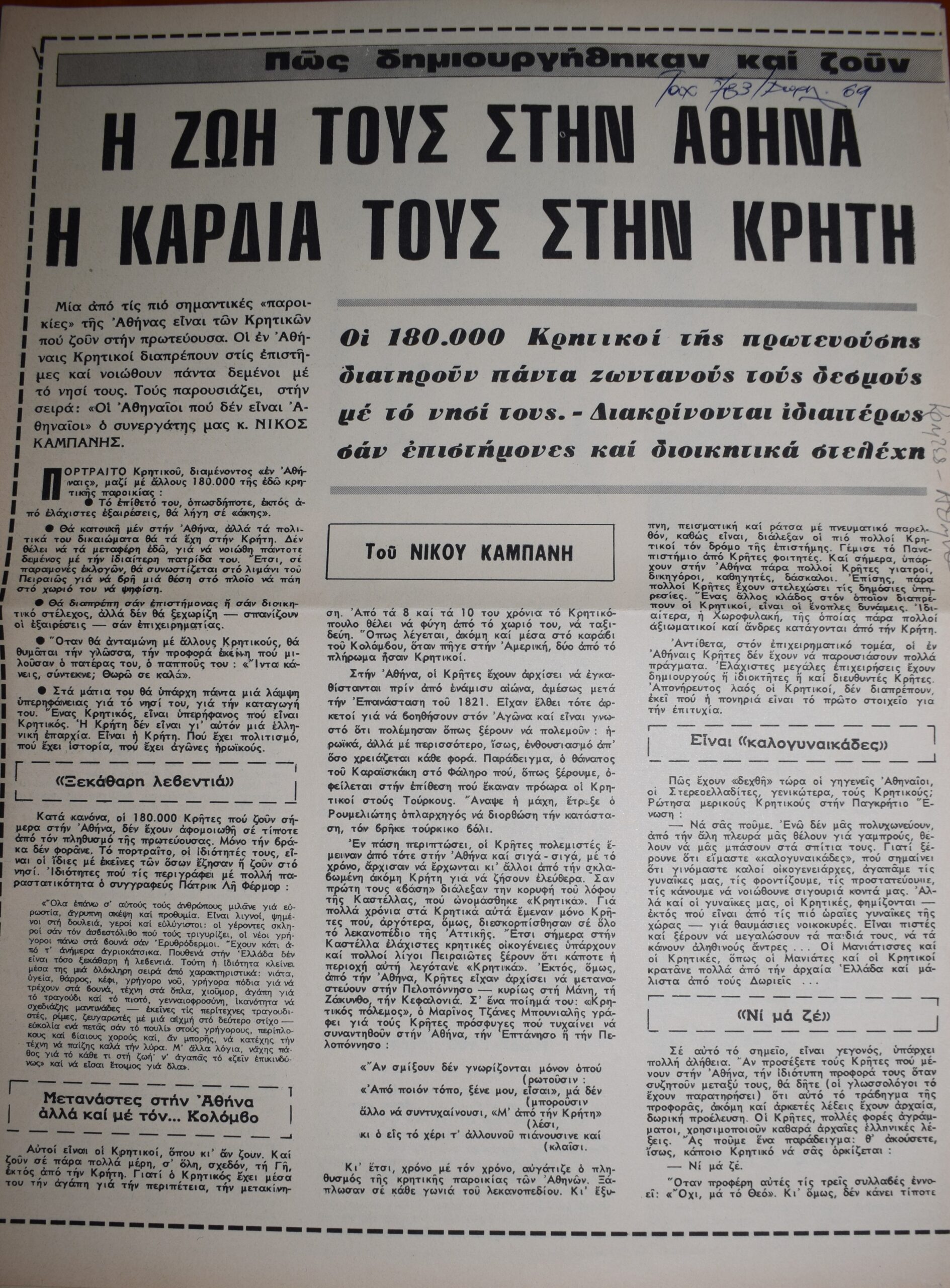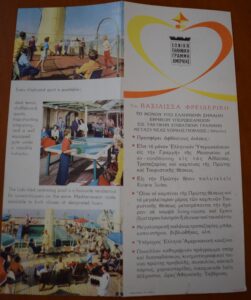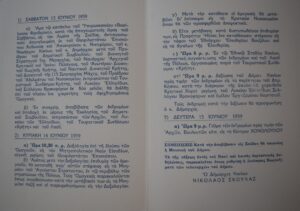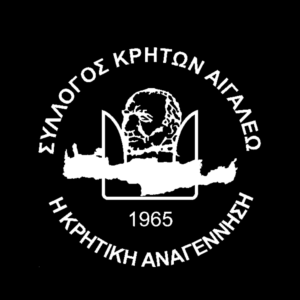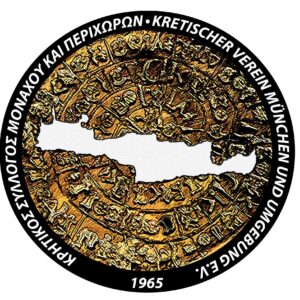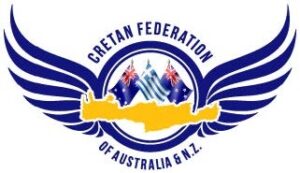The identity of Cretan migrants
Full Description
Collective activities have always cultivated a Cretan migrant identity and, through the years, organising and participating in them has remained an active process for the Cretans living away from the island, asserting what research has already indicated, namely that an identity is imbued with meaning by the presence of the other. From as early as the 1950s, we can find traces of collective action by Cretans who had migrated abroad before the war and later assisted and welcomed the new migrants who arrived postwar. Identity formation practices, such as collective organisation, family networking strategies within the Cretan community, and various individual practices which promoted Cretan identity, were more or less widespread depending not only on the number of Cretan migrants in the area, but also on the different dynamics of the Cretan identity developing in different localities.
By tracking these collective actions and organisations, we can obtain a broad picture about two important facts: on the one hand, the wide dispersion of Cretan population across the world through migration, and on the other, the elements of the Cretan identity migrant Cretans cultivate to shape their ‘Cretanness’, a quality of which most of them are inordinately proud because it sets them apart from the others, whether Greeks or foreigners.
A common practice aimed at strengthening the bonds among migrants and between migrants and their homeland was organising group trips to Crete. The brochures from one of these trips survive in the archive of the Municipal Library of Chania. In June 1959, the Pan-Cretan Association of America organised a journey on the ocean liner Vasilissa Freideriki, which would directly link New York and Chania. The information brochure distributed among the Cretans of America read: ‘Join the ranks of travellers to Crete so that we can prove once again how deep our love runs for our glorious homeland, motherland to the bravest of men. We especially recommend the participation of our youth, so that they can get to know from up close the birthplace of their parents and take pride in its majesty and glory’.
These trips were treated as a consequential event not just by the Cretan migrant community, but also by the native Cretans. The local authorities and relevant collective entities, such as traditional dance troupes, prepared a programme filled with activities to honour and welcome their guests. There were two main reasons for this enthusiastic response. The first was the fact that rich migrants and migrant organisations donated funds which helped cover the island’s needs in certain sectors, like healthcare and education. More generally, migrant remittances provided much needed financial support to the people of the island, especially from the 1960s onwards. The second reason was the desire to make the cultivation of a Cretan identity a mutual endeavour involving both the diaspora and the motherland.
To welcome the Greek Americans participating in this particular group trip, the Cretans had prepared a three-day welcoming festival. The importance attached to migration and the relations between natives and migrants is indicated by the sheer number of people involved in the welcoming events, the significance of the institutions and entities participating, the height of the incurred costs at a time of economic hardship, and the profound symbolism contained in the guests’ itinerary. Just the welcoming ceremony for the ship would gather the most prominent political and institutional figures of the island at the port of Souda: the Bishop, the Prefect, the Mayor, the President of the Municipal Council, the Commander of the 5th Army Division, the Admiral – Commander of the Navy for the Cretan and Aegean Sea, the Police Commissioner of Crete, the Naval Commander of Crete, the Commander of the 115th Air Force Division, the President of the Brotherhood running the local hospital, the representative of the Tourist Union ‘Crete’, the representative of Lykeion ton Ellinidon, a major educational institution, and two members from the Folk Music and Dance Association. They were, of course, joined by throngs of common people.
The Christian and national character of the migrants’ visit to Crete – in this order – was reflected in the guests’ itinerary, who, on the first day after their arrival, were scheduled to visit first the Metropolitan Church, and then the Tomb of the Unknown Soldier. Their visit to the State Hospital was indicative of which facilities received financial support from the migrants.
Ten years later, Tachydromos magazine published a feature on the Cretans of Athens. The article was aimed at a wider audience since Tachydromos was a national magazine, so the representations included in the feature were meant to paint a picture of ‘Cretanness’ for Cretans and non-Cretans alike. One of the constitutive elements of this identity, which is common among many representations of Cretans, was their strong and intimate connection with their homeland, a characteristic so prominent it merited a place in the article’s title: ‘Their life in Athens, their heart in Crete’. The article outlined ‘the profile of the Cretan who lives in Athens’: the quintessential Cretan man can be recognised by his last name which always ends in -akis. He has not assimilated to life in the capital, but instead leads his life just like people do on the island, with a ‘passion for life […] a straightforward and courageous attitude […] the old men are tough […] the young are fast […] they love living on the edge […] always ready for anything’. They are also sought-after husbands because ‘they dote on women […] protective and good family men’. Cretan women are ‘amazing housewives […] loyal and know how to raise their children properly, make them into real men’. According to the feature, it wasn’t only the 180,000 Cretans living in Athens who shared these qualities, but all Cretan migrants ‘no matter where they live. And they live in many places, almost everywhere on Earth […] because Cretans love adventure and movement by nature’.
Fifteen years later, in 1986, the description of the Cretans of Athens in the newspaper Dimokratis is so similar that it feels like no time has passed since the 1969 feature in Tachydromos. ‘A Crete outside of Crete. Just as vibrant, passionate, dynamic […] fighting fiercely to keep the umbilical cord connecting them to the motherland intact. [The Cretans of Athens] have not changed their character or their attitude. They remain Cretan, this distinct race’. These oft-repeated descriptions compose a narrative which floats above time. They create an image of the Cretan man, but also the Cretan woman, which is essentially non-historical and instead consists of innate characteristics. As a result, an impression is created that ‘Cretanness’ is a quality which is passed down through genetics and is, therefore, indisputable. Another example of how pervasive and long-lasting this narrative is can be found in the following extract from the documentary ‘The Haunts – Stories of Vulgar Civilisation: The internal migrants’ coffeehouses’, produced in 2019: ‘”Buy him a drink!” Another guy walks in. “Buy him a drink!” This phrase, “buy him”, gives you dignity, lifts you up, you’re saying “look at me”! […] My father told me, “Son, […] when you go to your friend’s house, don’t look his wife, his mother, his sister, his daughter in the eye and don’t stare at their breast. Your gaze will wander over them, unfocused, and you will always address the man […] We’re a different race of people. Yes, a different race’.
Cretan associations played a major role in this identity formation process as well as in the establishment of strong bonds within migrant communities both in Greece and abroad. Over the past decade, about 80 active Cretan associations have been recorded in the Prefecture of Attica and 25 in the rest of the country, excluding Crete. Many associations have also been created internationally, in every city where Cretan migrants have resettled. These organisations engage in different activities and some might be more active than others, but their names, logos, and activities emphasise the common reference points of all Cretan migrants: concepts like courage, honour and dignity; practices such as throwing feasts and singing ‘mantinades’, the traditional Cretan couplets accompanied by music; objects like the Cretan lyra, the ‘vraka’ (men’s traditional wide breeches), raki, and embroideries; and heroic narratives, such as the Battle of Crete and the Siege on the Arkadi Monastery.
Bibliography
Dimitra Gefou-Madianou, Self and ‘other’. Identities and practices in Greece and Cyprus, Gutenberg, Athens 2006.
Konstantina Spantidaki, The formation of Cretan identity in modern Greece, graduate thesis, Department of Geography, Harokopio University of Athens, Athens 2012.
Vassilis Patronis, Economy, Society and State in Greece (18th-20th century), Kallipos Open Academic Editions 2015.
‘The internal migrants’ coffeehouses’, The Haunts – Stories of Vulgar Civilisation, ERT, 02/06/19.
